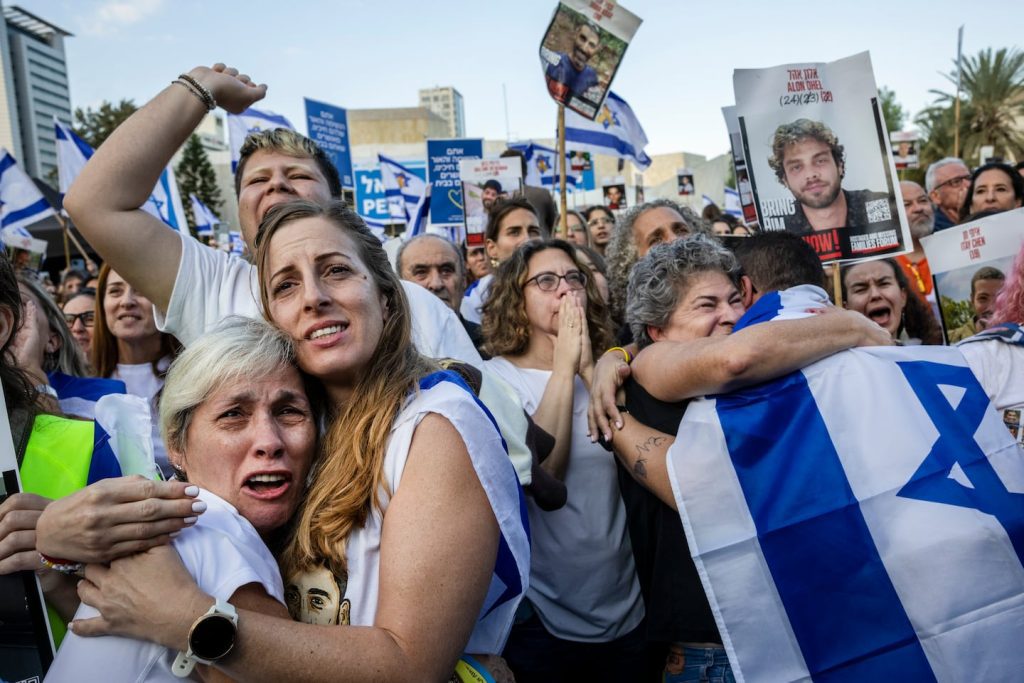On Monday, Israel received four deceased hostages, with an additional 24 expected to be handed over as part of the initial phase of a ceasefire. This arrangement also mandates Israel to permit an influx of food and humanitarian supplies into Gaza.
In Gaza, there was an eruption of joy for the return of prisoners from Israel, igniting hope for an end to the violence. Nevertheless, the suffering continues for Palestinians weary from war. The region has been ravaged by Israeli airstrikes, leaving the prewar economy in shambles, basic services in chaos, and many homes destroyed. The long-term reconstruction process remains uncertain, and it could take years.
Israel Claims the Deal Meets War Objectives
President Trump visited the region to commend the agreement, urging Israeli lawmakers to embrace a chance for broader peace. In Egypt, he and other global leaders convened to address the more complex aspects of the deal.
Prime Minister Netanyahu, who skipped the Egyptian meeting due to a Jewish holiday, reaffirmed his commitment to the agreement, asserting it fulfills all Israeli objectives. Despite Israel’s stance of not concluding the war until all hostages are released and Hamas is defeated, critics allege Netanyahu prolonged the conflict for political motives, which he disputes.
The conflict was ignited by Hamas’ attack on October 7, 2023, which resulted in 1,200 deaths and the capture of 251 individuals. Israel’s retaliation reportedly led to over 67,000 fatalities, according to Gaza’s Health Ministry, which does not specify between combatants and civilians. This ministry is associated with the Hamas administration, and its statistics are often seen as credible by the U.N. and various independent analysts.
Israel Celebrates the Return of Living Hostages
Public viewings in Israel drew large crowds celebrating the reunion of 20 male hostages with their families. Joyful cheers echoed as relieved faces shed tears, underscoring the emotional reunions.
Unlike prior releases, Hamas did not conduct ceremonies for the captives. Instead, families were given video calls from masked militants, offering them a first look at their loved ones before they returned home.
The release of hostages garnered widespread support in Israel, where many attended weekly protests calling for their release. The fate of the captives significantly influenced movements in Israel advocating for a cessation of warfare, as many citizens perceived Netanyahu’s dual objectives as incompatible.
Israeli Defense Minister Israel Katz indicated any delay by Hamas in returning the bodies of deceased hostages would be seen as a breach of the ceasefire agreement.
Israel Releases Approximately 1,900 Palestinian Prisoners
Freed prisoners were welcomed by large crowds in Beitunia and Khan Younis, with ex-prisoners flashing victory signs as they disembarked from buses directed towards the West Bank, Gaza, or exile.
Among those released are 250 individuals serving life sentences for assaults on Israelis, alongside 1,700 detained during the war without charge. The fates of these prisoners weigh heavily in Palestinian culture, as nearly everyone knows someone imprisoned by Israel, viewing them as freedom fighters.
Trump Celebrates the Agreement in Israel and Egypt
In his address to the Knesset, Trump urged Israeli lawmakers to pursue peace, asserting that Israel had achieved all it could through military force. He emphasized the need to translate military victories into lasting peace and prosperity for the Middle East.
Trump’s speech was interrupted momentarily by a protest from two Knesset members, one of whom held a sign reading, “Recognize Palestine.” In Egypt, alongside President Abdel-Fattah el-Sissi, Trump attended a summit with leaders from over 20 nations to discuss Gaza’s future and broader regional matters.
Despite Trump’s Optimism, Numerous Challenges Persist
Among the most challenging issues ahead is Israel’s demand for Hamas to disarm, a condition Hamas firmly refuses, instead seeking a complete withdrawal of Israeli troops from Gaza.
Currently, the Israeli military has pulled back from much of Gaza City and the southern region of Khan Younis, but remains in parts of Rafah and northern Gaza, as well as along the border with Israel.
The governance of Gaza is still uncertain. The U.S. plan proposes that an international authority oversee the territory, managed by Palestinian technicians for day-to-day operations. Hamas, however, insists that governance should be determined by Palestinians themselves.
The proposal envisions a role for Abbas’ Palestinian Authority, which Netanyahu has historically opposed, but it necessitates reforms within the Authority. It also suggests an Arab-led international security force in Gaza, with Palestinian police, allowing Israeli forces to withdraw as these units are deployed. Around 200 U.S. troops are in Israel to oversee the ceasefire.
The plan also hints at the potential for a future Palestinian state, an idea that is contentious for Netanyahu.
Magdy contributed from Cairo and Shurafa from Deir al-Balah, Gaza Strip. Additional reporting from Associated Press writers across various locations, including Massachusetts, Beirut, and Israel.



